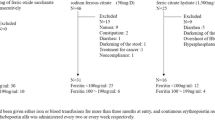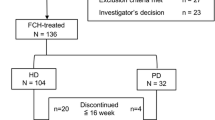Abstract
Purpose
Iron is usually administered in hemodialysis patients by parenteral route, as oral absorption is poor due to high hepcidin levels. However, administrations of intravenous iron and iron overload are associated with high oxidative stress and systemic inflammation that can affect patient survival. With this study, we evaluated an alternative type of oral iron for the treatment of anemia in hemodialysis patients. The formulation consists in ferric pyrophosphate covered by phospholipids plus sucrose ester of fatty acid matrix, named sucrosomial iron, whose absorption is not influenced by hepcidin.
Methods
Twenty-four (24) patients undergoing chronic hemodialysis switched iron supplementation from intravenous (ferric gluconate 62.5 mg weekly) to oral (sucrosomial iron, 90 mg weekly in 3 administrations of 30 mg) route for 3 months. Classical anemia, iron metabolism, inflammation and nutritional biomarkers were monitored, as well as biomarkers of oxidative stress, such as protein-bound di-tyrosines, protein carbonylation, advanced oxidation protein products and protein thiols.
Results
Over the 3 months, hemoglobin values remained stable, as the values of hematocrit and mean corpuscular volume. In parallel, other anemia parameters dropped, including ferritin, transferrin saturation and serum iron. On the other side, nutritional biomarkers, such as total proteins and transferrin, increased significantly during the time frame. We also observed a significant decrease in white blood cells as well as a non-significant reduction in C-reactive protein and some oxidative stress biomarkers, such as protein carbonyls and di-tyrosines.
Conclusion
Our study demonstrates that a therapy with sucrosomial iron in hemodialysis patients is safe and can maintain stable hemoglobin levels in a three-month period with a possible beneficial effect on oxidative stress parameters. However, the reduction of ferritin and transferrin saturation suggests that a weekly dosage of 90 mg is not sufficient in hemodialysis patients in the long time to maintain hemoglobin.



Similar content being viewed by others
Data availability
Data are available under reasonable circumstances by direct contact with the corresponding author.
Code availability
Not applicable.
References
Liyanage T, Ninomiya T, Jha V et al (2015) Worldwide access to treatment for end-stage kidney disease: a systematic review. Lancet 385(9981):1975–1982
Fishbane S, Spinowitz B (2018) Update on anemia in ESRD and earlier stages of CKD: core curriculum. Am J Kidney Dis 71:423–435
Fishbane S, Mathew A, Vaziri ND (2014) Iron toxicity: relevance for dialysis patients. Nephrol Dial Transplant 29:255–259
Eleftheriadis T, Liakopoulos V, Antoniadi G, Kartsios C, Stefanidis I (2009) The role of hepcidin in iron homeostasis and anemia in hemodialysis patients. Semin Dial 22(1):70–77
Wingard RL, Parker RA, Ismail N, Hakim RM (1995) Efficacy of oral iron therapy in patients receiving recombinant human erythropoietin. Am J Kidney Dis 25:433–439
Albaramki J, Hodson EM, Craig JC, Webster AC (2012) Parenteral versus oral iron therapy for adults and children with chronic kidney disease. Cochrane Database Syst Rev. https://doi.org/10.1002/14651858.CD007857.pub2
Shepshelovich D, Rozen-Zvi B, Avni T, Gafter U, Gafter-Gvili A (2016) Intravenous versus oral iron supplementation for the treatment of anemia in CKD: an updated systematic review and meta-analysis. Am J Kidney Dis 68:677–690
2012 Kidney Disease: Improving Global Outcomes (KDIGO) guidelines
Karaboyas A, Morgenstern H, Pisoni RL et al (2018) Association between serum ferritin and mortality: findings from the USA, Japan and European Dialysis Outcomes and Practice Patterns Study. Nephrol Dial Transplant 33:2234–2244
Kalantar-Zadeh K, Regidor DL, McAllister CJ, Michael B, Warnock DG (2005) Time-dependent associations between iron and mortality in hemodialysis patients. J Am Soc Nephrol 16:3070–3080
Bailie GR, Larkina M, Goodkin DA et al (2015) Data from the Dialysis Outcomes and Practice Patterns Study validate an association between high intravenous iron doses and mortality. Kidney Int 87(1):162–168
Galaris D, Barbouti A, Pantopoulos K (2019) Iron homeostasis and oxidative stress: an intimate relationship. Biochim Biophys Acta Mol Cell Res 1866(12):118535
Bresgen N, Eckl PM (2015) Oxidative stress and the homeodynamics of iron metabolism. Biomolecules 5:808–847
Silva B, Faustino P (2015) An overview of molecular basis of iron metabolism regulation and the associated pathologies. Biochim Biophys Acta Mol Basis Dis 1852:1347–1359
Lim PS, Wei YH, Yu YL, Kho B (1999) Enhanced oxidative stress in haemodialysis patients receiving intravenous iron therapy. Nephrol Dial Transplant 14:2680–2687
Tovbin D, Mazor D, Vorobiov M, Chaimovitz C, Meyerstein N (2002) Induction of protein oxidation by intravenous iron in hemodialysis patients: role of inflammation. Am J Kidney Dis 40:1005–1012
Drüeke T, Witko-Sarsat V, Massy Z et al (2002) Iron therapy, advanced oxidation protein products, and carotid artery intima-media thickness in end-stage renal disease. Circulation 106(17):2212–2217
Anraku M, Kitamura K, Shinohara A et al (2004) Intravenous iron administration induces oxidation of serum albumin in hemodialysis patients. Kidney Int 66(2):841–848
Nascimento MM, Suliman ME, Bruchfeld A et al (2004) The influence of hepatitis C and iron replacement therapy on plasma pentosidine levels in haemodialysis patients. Nephrol Dial Transplant 19(12):3112–3116
Kuo KL, Hung SC, Wei YH, Tarng DC (2008) Intravenous iron exacerbates oxidative DNA damage in peripheral blood lymphocytes in chronic hemodialysis patients. J Am Soc Nephrol 19:1817–1826
Agarwal R, Vasavada N, Sachs NG, Chase S (2004) Oxidative stress and renal injury with intravenous iron in patients with chronic kidney disease. Kidney Int 65:2279–2289
Liakopoulos V, Roumeliotis S, Gorny X, Dounousi E, Mertens PR (2017) Oxidative stress in hemodialysis patients: a review of the literature. Oxid Med Cell Longev 2017:1–22
Liakopoulos V, Roumeliotis S, Zarogiannis S, Eleftheriadis T, Mertens PR (2019) Oxidative stress in hemodialysis: causative mechanisms, clinical implications, and possible therapeutic interventions. Semin Dial 32:58–71
Agarwal R, Warnock D (2022) Issues related to iron replacement in chronic kidney disease. Semin Nephrol 22(6):479–487. https://doi.org/10.1053/snep.2002.35972 (PMID: 12430092)
Ebert T, Neytchev O, Witasp A, Kublickiene K, Stenvinkel P, Shiels PG (2021) Inflammation and oxidative stress in chronic kidney disease and dialysis patients. Antioxid Redox Signal. https://doi.org/10.1089/ars.2020.8184
Cobo G, Lindholm B, Stenvinkel P (2018) Chronic inflammation in end-stage renal disease and dialysis. Nephrol Dial Transplant 33(suppl 3):iii35–iii40
Brilli E, Romano A, Fabiano A, Zambito Y, Raimondo F, Tarantino G (2016) Sucrosomial technology is able to promote ferric iron absorption: pre-clinical and clinical evidences. Blood 128(22):3618
Gómez-Ramírez S, Brilli E, Tarantino G, Muñoz M (2018) Sucrosomial(®) iron: a new generation iron for improving oral supplementation. Pharmaceuticals (Basel) 11:97
Fabiano A, Brilli E, Mattii L et al (2018) Ex vivo and in vivo study of sucrosomial(®) iron intestinal absorption and bioavailability. Int J Mol Sci 19:2722
Colombo G, Clerici M, Garavaglia MEM et al (2016) A step-by-step protocol for assaying protein carbonylation in biological samples. J Chromatogr B Analyt Technol Biomed Life Sci 1019:178–190
Eschbach JW, Cook JD, Scribner BH, Finch CA (1977) Iron balance in hemodialysis patients. Ann Intern Med 87:710–713
Tomosugi N, Kawabata H, Wakatabe R et al (2006) Detection of serum hepcidin in renal failure and inflammation by using ProteinChip System. Blood 108(4):1381–1387. https://doi.org/10.1182/blood-2005-10-4043
Young B, Zaritsky J (2009) Hepcidin for clinicians. Clin J Am Soc Nephrol 4:1384–1387
Pisani A, Riccio E, Sabbatini M, Andreucci M, Del Rio A, Visciano B (2014) Effect of oral liposomal iron versus intravenous iron for treatment of iron deficiency anaemia in CKD patients: a randomized trial. Nephrol Dial Transplant 30:645–652
Kalantar-Zadeh K, Ikizler TA, Block G, Avram MM, Kopple JD (2003) Malnutrition-inflammation complex syndrome in dialysis patients: causes and consequences. Am J Kidney Dis 42:864–881
Hougen I, Collister D, Bourrier M et al (2018) Safety of intravenous iron in dialysis. Clin J Am Soc Nephrol 13:457–467
Macdougall IC, White C, Anker SD et al (2018) Intravenous iron in patients undergoing maintenance hemodialysis. N Engl J Med 380:447–458
Ferrari P, Kulkarni H, Dheda S et al (2011) Serum iron markers are inadequate for guiding iron repletion in chronic kidney disease. Clin J Am Soc Nephrol 6:77–83
Fabiano A, Brilli E, Fogli S et al (2018) Sucrosomial® iron absorption studied by in vitro and ex-vivo models. Eur J Pharm Sci 111:425–431
Kalantar-Zadeh K, Kopple JD, Block G, Humphreys M (2001) H. A malnutrition-inflammation score is correlated with morbidity and mortality in maintenance hemodialysis patients. Am J Kidney Dis 38:1251–1263
Colombo G, Reggiani F, Cucchiari D (2017) Plasma protein-bound di-tyrosines as biomarkers of oxidative stress in end stage renal disease patients on maintenance haemodialysis. BBA Clin 7:55–63
Colombo G, Reggiani F, Podestà MA, Garavaglia ML, Portinaro NM, Milzani A, Badalamenti S, Dalle-Donne I (2015) Plasma protein thiolation index (PTI) as a biomarker of thiol-specific oxidative stress in haemodialyzed patients. Free Radic Biol Med 89:443–451
Funding
This research has been partially funded by Pharmanutra SpA (Pisa, Tuscany, Italy).
Author information
Authors and Affiliations
Contributions
FR was involved in data collection and analysis and writing of the manuscript, GC, EA, LL, AM and IDD were involved in the research protocol, analysis of oxidative stress biomarkers and writing of the manuscript, SF and CA were involved in the research protocol and patients recruitment, DC conceived the study and was involved in the research protocol, data analysis and writing of the manuscript.
Corresponding author
Ethics declarations
Conflicts of interest
DC has received speaker fees from Pharmanutra. All the other Authors reported no conflict of interest.
Ethical approval
The study was approved by Humanitas Clinical and Research Center review board before initiation and carried out according to the Code of Ethics of the World Medical Association (Declaration of Helsinki).
Consent to participate
A signed informed consent has been obtained for each participant.
Consent for publication
All the authors agree on the publication of the manuscript.
Additional information
Publisher's Note
Springer Nature remains neutral with regard to jurisdictional claims in published maps and institutional affiliations.
Rights and permissions
About this article
Cite this article
Reggiani, F., Colombo, G., Astori, E. et al. Preliminary experience on the use of sucrosomial iron in hemodialysis: focus on safety, hemoglobin maintenance and oxidative stress. Int Urol Nephrol 54, 1145–1153 (2022). https://doi.org/10.1007/s11255-021-02983-8
Received:
Accepted:
Published:
Issue Date:
DOI: https://doi.org/10.1007/s11255-021-02983-8




